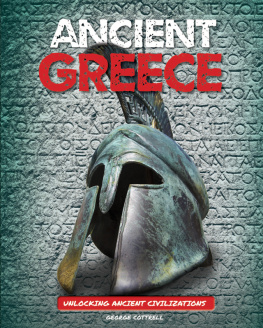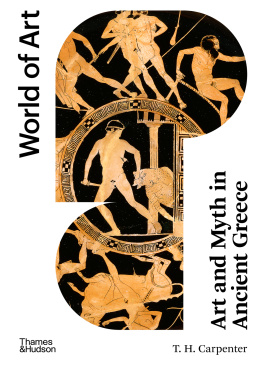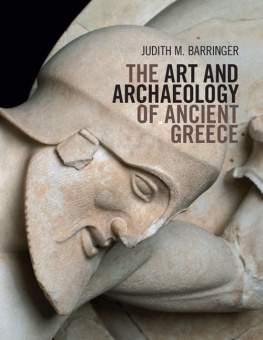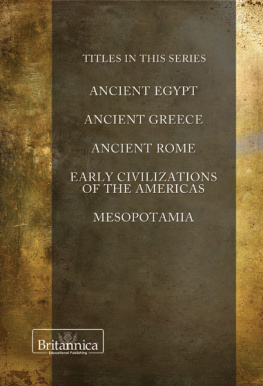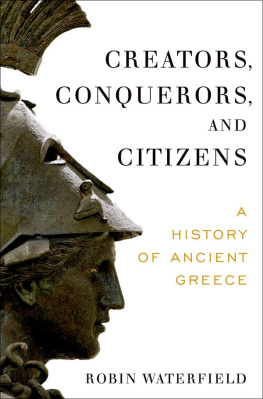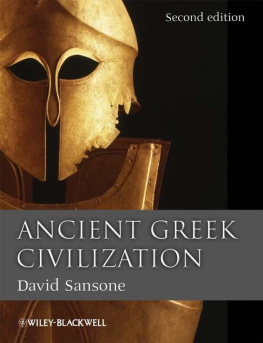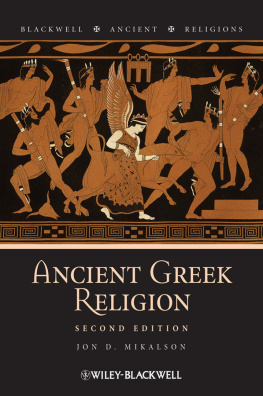Ancient Greece
SECOND EDITION
Ancient Greece
From Prehistoric to
Hellenistic Times
THOMAS R. MARTIN
Yale UNIVERSITY PRESS
New Haven & London

Published with assistance from the Mary
Cady Tew Memorial Fund.
First edition 1996. Updated in 2000 with new suggested readings and illustrations. Second edition 2013.
Copyright 1996, 2013 by Yale University.
All rights reserved.
This book may not be reproduced, in whole or in part, including illustrations, in any form (beyond that copying permitted by Sections 107 and 108 of the U.S. Copyright Law and except by reviewers for the public press), without written permission from the publishers.
Yale University Press books may be purchased in quantity for educational, business, or promotional use. For information, please e-mail sales.press@yale. edu (U.S. office) or sales@yaleup.co.uk (U.K. office).
Set in Joanna type by Integrated
Publishing Solutions.
Printed in the United States of America.
Library of Congress Cataloging-in-Publication Data
Martin, Thomas R., 1947
Ancient Greece : from prehistoric to Hellenistic times / Thomas R. Martin.Second Edition.
pages cm.
Includes bibliographical refences and index.
ISBN 978-0-300-16005-5 (pbk. : alk. paper) 1. GreeceHistoryTo 146 B.C. I. Title.
DF77.M3 2013
938dc23 2012043154
A catalogue record for this book is available from the British Library.
This paper meets the requirements of ANSI/NISO Z39.481992 (Permanence of Paper).
10 9 8 7 6 5 4 3 2 1
This book is dedicated to the students who have over the years asked questions that continually kept me thinking anew about the history of ancient Greece, to the colleagues who have so often helped me work through the challenges of presenting that history in the classroom, to the readers who have sent me comments and suggestions, and to the people of Greece, past and present, whose xenia has always inspired and humbled me, in good times and bad.
CONTENTS
Timelines appear on pages
MAPS, PLANS, TABLES, AND FIGURES
Maps
Plans
Tables
Figures
PREFACE
The first edition of this book came out in 1996, as a companion and a supplement to the overview of ancient Greek history included in the Perseus Project. At that time, before the explosion of the Internet, Perseus was released on CD-ROM, which was the only medium then available that allowed the integration of narrative, illustrations, and access to the full texts in translation and the original languages of ancient sources. That original overview has now been online for more than a decade as part of the Perseus Digital Library (www.perseus.tufts.edu/hopper/) under the title An Overview of Classical Greek History from Mycenae to Alexander (www.perseus.tufts.edu/hopper/text?doc=Perseus:text:1999.04.0009). As best as can be estimated, it has been viewed online more than a million times from all around the world. I take heart from that figure that the history of ancient Greece retains its fascination for many, many people, myself included.
As a policy decision taken for multiple reasons, the overview in Perseus has remained unchanged over the years. This printed book has now been updated twice (though with the same coverage and arrangement of topics). It can no longer be said to be a companion to the Perseus overview, but its inspiration remains the spirit and dedication to the goal of the wide dissemination of knowledge that has motivated the Perseus team throughout the history of that groundbreaking project. For this and more, the world of those interested in ancient Greece in particular and digital libraries in general owe a boundless debt of gratitude to and admiration for Gregory Crane, Professor of Classics and Winnick Family Chair of Technology and Entrepreneurship at Tufts University and Alexander von Humboldt Professor at the University of Leipzig, scholar and friend and fellow Red Sox fan through thick and thin.
ACKNOWLEDGMENTS
Again, I want to express in the first place my abiding appreciation for the patience, encouragement, and guidance that Jennifer Banks (senior editor, Yale University Press) has repeatedly given me; her many contributions have been invaluable. Piyali Bhattacharya and Heather Gold (editorial assistants) were unstinting in their attention to the project, as was Suzie Tibor in her art research in locating the new images for this edition. Kate Davis (copy editor) earns warm thanks for her prompt and meticulous editing to improve the text, as does Margaret Otzel (senior editor, Yale University Press) for her unfailingly responsive and encouraging work to turn the manuscript into a book. The honest criticisms and thorough analysis of the anonymous reviewers aided me greatly in improving the narrative from beginning to end. My wife and fellow philhellene, Ivy Suiyuen Sun, has supported me from the very beginning forty years ago, when we began our marriage and our love of things Hellenic during our first sojourn in Greece.
ABBREVIATIONS
CAF Theodorus Kock. Comicorum Atticorum Fragmenta (Leipzig, Germany: Teubner, 18801888; reprint, Utrecht, Netherlands: HES, 1976).
D.-K. Hermann Diels. Die Fragmente der Vorsokratiker. Ed. Walther Kranz. 11th ed. (Zurich: Weidmann, 1964).
FGrH Felix Jacoby. Die Fragmente der griechischen Historiker (Leiden, Netherlands: Brill, 19541964).
GHI Russell Meiggs and David Lewis, eds. A Selection of Greek Historical Inscriptions to the End of the Fifth Century B.C. (Oxford: Clarendon Press, 1988).
IGInscriptiones Graecae. Vol. 4, 2nd ed.; vol. 1, 3rd ed. (Berlin: De Gruyter, 1929; 1981).
OGIS Wilhelm Dittenberger. Orientis Graeci Inscriptiones Selectae (Leipzig, Germany: S. Hirzel, 19031905; reprint, Hildesheim, Germany: Olms, 1970).
NOTE ON CITATIONS, SOURCES, AND DATES
The term primary sources, as used here (and commonly in classical studies), refers to ancient texts, whether literary, documentary, epigraphic, or numismatic. To help readers find the passages in primary sources that are embedded in the text of this book, citations will be presented wherever possible using the standard internal reference systems of those sources that are conventional in modern scholarly editions and that are used in many, but not all, modern translations. So, for example, the citation Pausanias, Guide to Greece 4.2.3 means that the passage is book 4, section 2, subsection 3 of that work by Pausanias. This will enable readers to find the passage in question in any modern edition or translation that includes the internal reference system.
Secondary sources accordingly refers to postclassical or modern scholarship about these ancient sources and the history that they describe. The embedded citations of secondary sources contain the name of the author or a short title, with the relevant page numbers or, in the case of catalogued objects such as inscriptions or coins, the reference number of the object.
Full bibliographic information on modern translations of primary sources and on secondary sources can be found in the Suggested Readings at the end of this book.
Dates not marked as B.C. or A.D. should be assumed to be B.C. Dates given in parentheses following the name of a person indicate birth and death dates, respectively, unless preceded by ruled, which indicates regnal dates.
Next page

